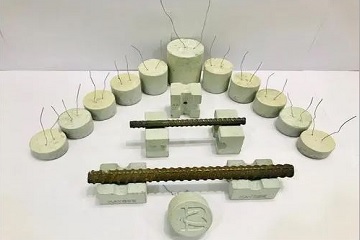Table of Contents
What Is Cover Block?
A cover block is basically a spacer that is used to lift the rebar matrix off the ground so that concrete may flow underneath the rebar. In order to prevent corrosion of the rebar, it requires to be fully embedded in concrete

It usually requires about 2 to 3 inches of coverage on all sides. Hence the cover block lifts the rebar up by about 2 to 3 inches and becomes a permanent and integral part of the poured concrete, assure that no part of the rebar sags and minimizes that required concrete coverage during the pour.
Properties Of Cover Blocks:
Cover blocks must have sufficient compressive strength to withstand the weight of the reinforcement steel and the concrete.
Cover blocks must be durable and resistant to weathering, chemicals, and other environmental factors that may cause degradation.
Cover blocks must have the right size and shape to provide adequate spacing and support to the reinforcement steel and the formwork.
Cover blocks must have good bonding with the reinforcement steel and the concrete to ensure that the reinforcement remains in place and provides the desired strength to the structure.
Types Of Cover Blocks Used In Construction:
There are various types of covering blocks depending on the type of material used:
- Wooden cover block.
- Steel cover block.
- PVC block.
- Cement masonry cover block.
- Aluminum cover block.
- Stone cover block.
Why Cover Blocks Are Used In Construction?
Cover blocks are used for the reasons as follows:
- To maintain a specified spacing between the rebar and the shuttering.
- To prevent the steel reinforcement bars from environmental effects to protect their corrosion.
- To furnish thermal insulation, which prevents the reinforcement bars from fire.
- To provide reinforcing bars sufficient embedding to enable them to be stressed without slipping.
Size Of Cover Blocks For Various Structurul Members
Here I have listed the size of cover blocks for different structural members which are normally used in construction.
- Size of Cover Blocks for Beam = Minimum 20 mm
- Size of Cover Blocks for Column = Minimum 40 mm
- Size of Cover Blocks for Footing = Minimum 50 mm
- Size of Cover Blocks for Shear Wall = Minimum 30 mm
- Size of Cover Blocks for Retaining Wall = Minimum 20 mm
- Size of Cover Blocks for Staircase = Minimum 15 mm
Applications of Cover Blocks:
Concrete cover blocks are widely used in various applications in reinforced concrete construction. Some common applications of cover blocks are:
- Slab Construction: Cover blocks are used to provide adequate spacing between the reinforcement steel and the formwork in slab construction.
- Column Construction: Cover blocks are used to provide adequate spacing and support to the reinforcement steel in column construction.
- Beam Construction: Cover blocks are used to provide adequate spacing and support to the reinforcement steel in beam construction.
- Retaining Walls: Cover blocks are used to provide adequate spacing and support to the reinforcement steel in retaining wall construction.
Advantages Of Concrete Cover Blocks:
Concrete cover blocks offer several advantages in reinforced concrete construction. Some important advantages of cover blocks are:
- Strength and Durability: Cover blocks provide the required spacing and support to the reinforcement steel, thus ensuring the strength and durability of the concrete structure.
- Easy to Install: Cover blocks are easy to install and require no special tools or equipment.
- Cost-effective: Cover blocks are cost-effective compared to other reinforcement accessories, such as spacers and chairs.
- Resistance to Weathering and Chemicals: Cover blocks are resistant to weathering, chemicals, and other environmental factors that may cause degradation.
Disadvantages Of Cover Blocks:
Concrete cover blocks also have some disadvantages that should be considered before their use. Some important disadvantages of cover blocks are:
- Inadequate Bonding: Cover blocks may not have adequate bonding with the reinforcement steel and the concrete, which may affect the overall strength of the structure.
- Thermal Conductivity: Cover blocks may have higher thermal conductivity than other insulation materials, which may result in heat loss or gain in the concrete structure.
- Limited Availability: Some types of cover blocks, such as rubber cover blocks, may not be readily available in all areas, which may increase their cost and delay construction.
- Maintenance: Cover blocks may require regular maintenance to ensure their effectiveness and durability.
Sum Up:
In reinforced concrete construction, cover blocks play an essential role in providing adequate spacing and support to the reinforcement steel and formwork.
Different types, sizes, and shapes of cover blocks are available and they offer several advantages, including strength, durability, and cost-effectiveness.
However, it is important to consider their disadvantages, such as inadequate bonding and higher thermal conductivity, before using them.
To ensure the effectiveness and durability of the concrete structure, it is crucial to choose the right type and size of cover block and to properly install and maintain them.
